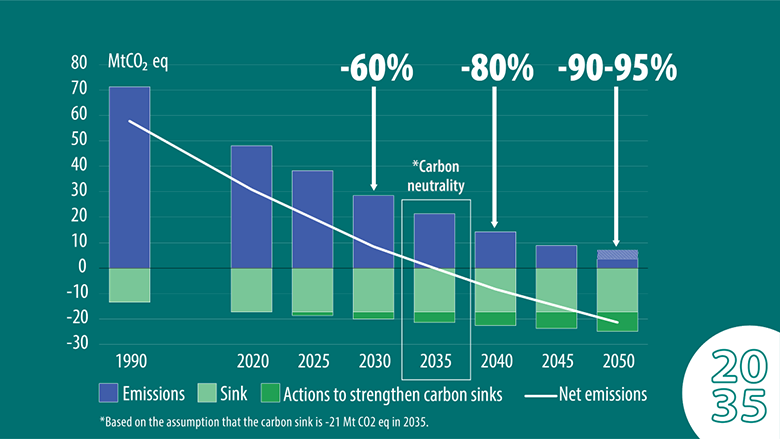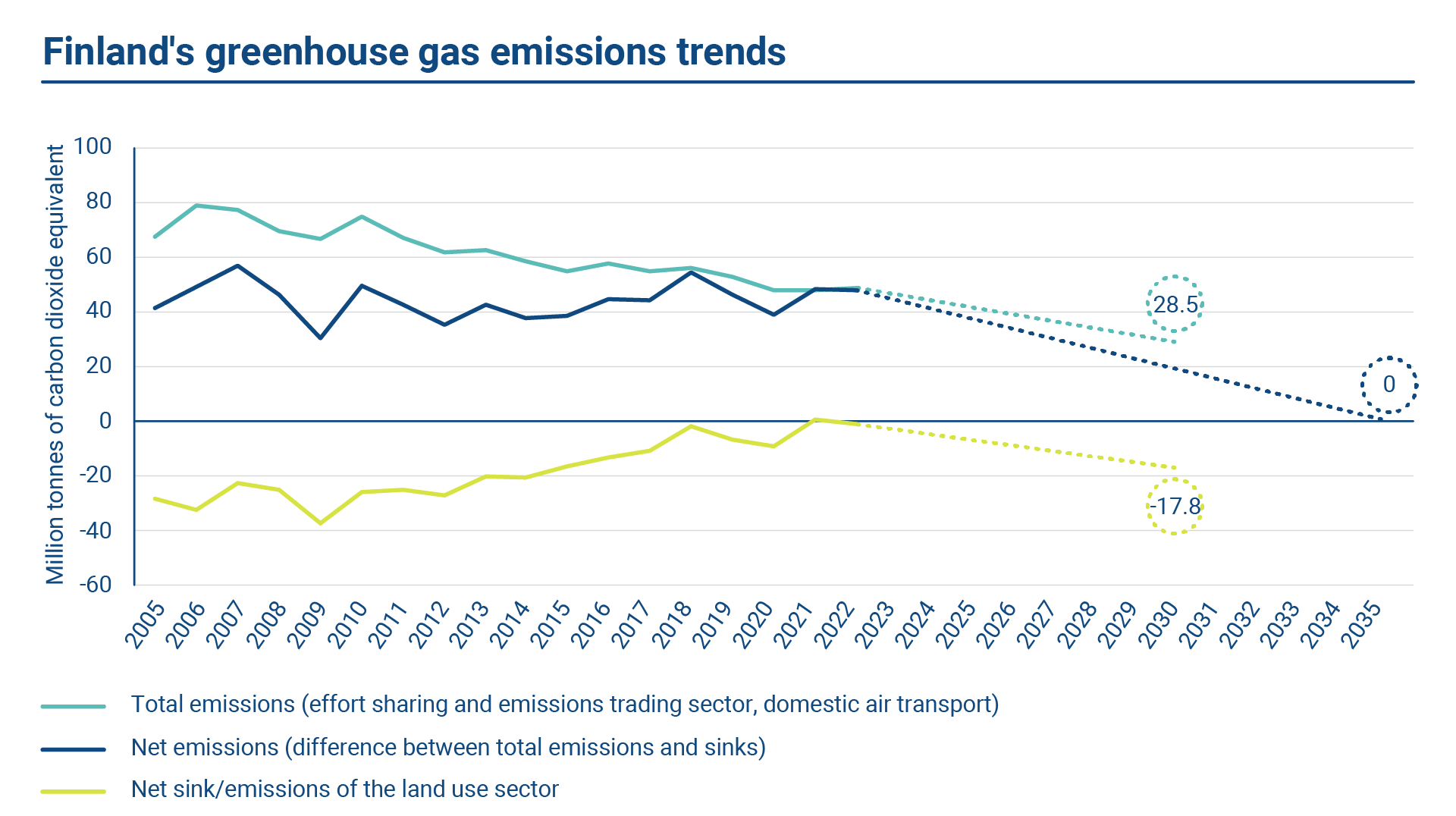Three targets for the future:
- According to the government programme, the Finnish Government is committed to meeting emission reduction targets and moving towards carbon neutrality in 2035 followed by carbon negativity.
- Finland’s obligation under EU law is to halve the effort sharing sector’s green house gas emissions (non-ETS) by 2030 (from 2005 levels).
- The new Climate Change Act entered into force in 2022. The Act set emission reductions targets for 2030, 2040 and 2050 and laid down the target of carbon neutrality in 2035.
Key pillar of Finland’s climate policy is the Climate Change Act. The scope of the Act was extended to cover emissions from the land use sector (i.e. land use, forestry and agriculture) and for the first time the Act includes a target to strengthen carbon sinks.
The emission reduction targets in the Climate Change Act are based on the recommendations of the Finnish Climate Change Panel. The emission reduction targets are -60% by 2030, -80% by 2040 and at least -90% but aiming at -95% by 2050, compared to the levels in 1990.

Source: Ministry of the Environment
Annual Climate Report: Finland’s emissions decreased by 3% in 2022
An annual way of monitoring the development of Finland’s emissions and progress towards emission reduction targets is the Annual Climate Report. The latest release is from July 2023, after which Statistics Finland have released one data revision, in December 2023.
Key findings:
- While Finland’s total emissions decreased in 2022 compared to the year before, additional measures are needed particularly to strengthen the carbon sink of the land use sector
- In 2022, the land use sector was a net emission source
- The achievement of the Finnish effort sharing sector’s obligation set at the EU level is also uncertain.

Under the national Climate Change Act, Finland’s net emissions should be zero or negative by 2035. By 2030, the total emissions must be reduced by 60% compared to the 1990 level. At the EU level, it has been agreed that the carbon sink of the Finnish land use sector must be -17.8 million tonnes of CO2 equivalent by 2030. Annual Climate Report data for 2022 are based on Statistics Finland’s proxy estimates, which will be specified later. Source: Annual Climate Report 2023
In 2022, Finland’s greenhouse gas emissions decreased by 3% compared to the previous year. According to current estimates, Finland’s emissions reduction trend is in line with the target for 2030. Emissions have decreased by 35% compared to 1990, and by 46% compared to 2003, when emissions were at their highest during the 1990–2022 period. Over the past five years, Finland’s total emissions have decreased by an average of 4% annually.
Based on current estimates, the target of reducing emissions by -60% by 2030 is possible to achieve. The emissions trading sector’s emissions decreased substantially in 2022, by 6% in total. Changes in energy use were the most significant reason for the reduction in emissions. The consumption of natural gas halved due to rising natural gas prices and the discontinuation of Russian imports. The rapid phasing out of fossil fuels in electricity and heat production will be accomplished in the coming years. The rate of emission reductions in the emissions trading sector may also be faster than anticipated.
Finland’s carbon sinks are well short of the targeted level. In 2022, the land use sector (LULUCF) was a net emission source when its emissions exceeded removals by 4.5 million tonnes of CO₂-equivalent. The size of the forest carbon sink varies substantially from one year to the next, but the sink has declined significantly over the past few years. The weak development is attributable to increased forest harvesting, the slowing of forest growth and the increased soil emissions from peatlands.
The achievement of the Finnish effort sharing sector’s obligation set at the EU level is also uncertain. This sector’s emissions decreased by 3% in 2022 when compared to 2021. Nevertheless, emissions from transport and agriculture – which are the largest sources of emissions in the sector – were largely unchanged from the previous year. Finland’s obligation agreed upon at the EU level is to reduce emissions by 50% by 2030. Examples of the measures aimed at reducing transport emissions include the fuel distribution obligation and accelerating the electrification of transport.
Key policy measures to achieve the government’s climate targets
The focus of Finnish government is on promoting the clean transition and investments in industry. Finland seeks to strengthen its competitiveness and attractiveness as an investment target for renewable industries by doubling its production of clean electricity. The share of renewable energy in energy production will be increased, and action will be taken towards phasing out the use of fossil fuels in heat and electricity production by the 2030s at the latest. More information can be found on the Government Programme: Finland and clean energy.
We will update this article with a list of policy measures in 2024, as Finland’s new government gets fully going with its legislative work.
Here are Finland’s climate targets in a nutshell.
Further reading:
Read more about the Government’s climate policy:
Finland’s national climate policy (Ministry of the Environment)
Finland’s national climate and energy strategy (2022) is a medium-term action plan that covers all greenhouse gas emissions and removals achieved through carbon sinks:
Carbon Neutral Finland 2035 – national climate and energy strategy
National climate and energy strategy has been prepared in coordination with:
- Finland’s Medium-term climate change policy plan (2022) that applies to the effort-sharing sector, and
- Climate plan for the land use sector (2022) that includes specific measures taken to increase carbon sinks
Read more on the Climate Change Act 2022:
New Climate Change Act into force in July
